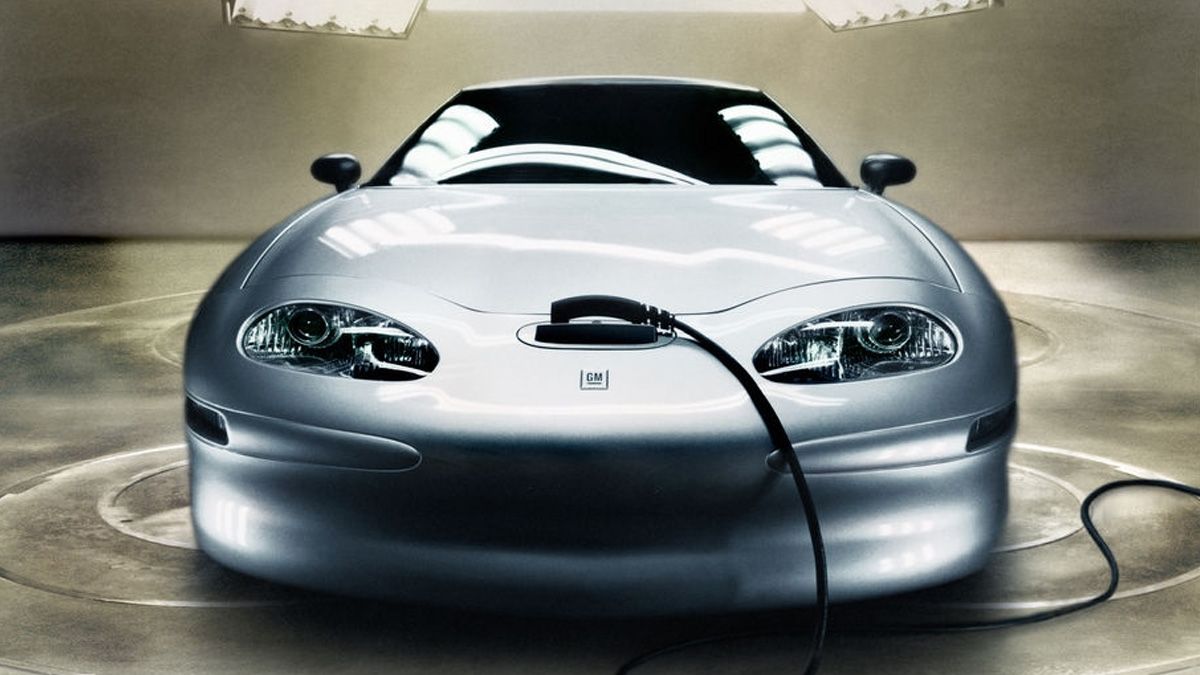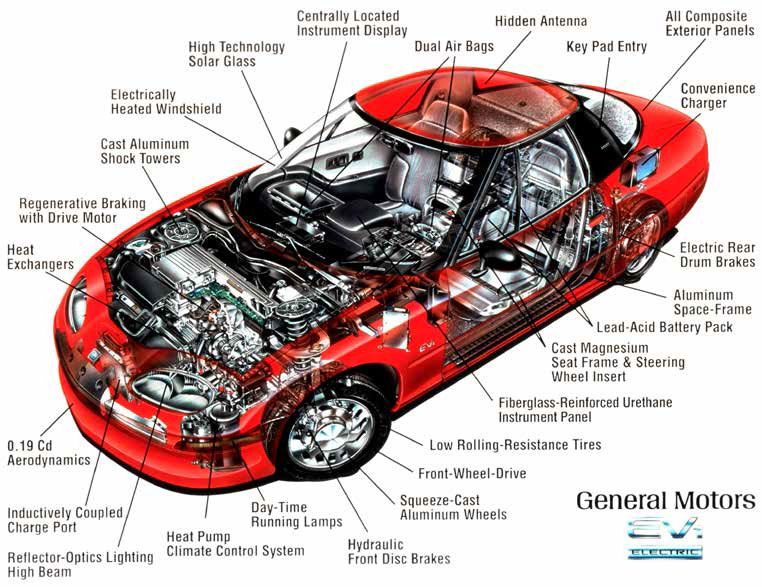Quick Links
Key Takeaways
The EV1 was a real electric car on the roads in 1996. So where did it go?
The modern electric car revolution is still in its early stages, but it could have started much earlier if history had gone a little differently. This is the story of the EV1, the first modern electric car from General Motors.
The Need for Electric Speed
In January 1990, General Motors showed off a concept car at that year's LA Auto Show, called the "Impact." It was an all-electric two-seat vehicle, designed from the ground up as an EV, instead of using an existing frame from a gas car. GM said it could go from zero to 60 miles per hour in 8 seconds. For comparison, the Tesla Model 3 Performance can do that in about 3 seconds, while the 2023 Chevy Bolt EV is advertised at 6.5 seconds.
The Impact was powered by 32 lead-acid batteries -- the same type of battery used in gas cars then and now. The official range was 124 miles, but the battery pack would need to be replaced every 20,000 miles, which GM estimated would cost around $1,500.
Even though the car was impressive, General Motors was hesitant to move it to mass production, expecting low demand from buyers. However, some U.S. states like California and New York were hoping to pass laws to increase adoption of electric cars, with the goal of further reducing air pollution in cities and decreasing dependence on oil -- the last major oil supply crisis was only a decade prior. The Impact concept car showed governments that such laws could be practical, as usable EVs were becoming a reality.
The California Air Resources Board passed a Low Emission Vehicle and Clean Fuels program later that year, in September 1990, which required low-emission vehicles (LEVs) to make up a certain percentage of all cars that a given company sold California. The original rules called for LEVs to be 2% of each car maker's sales, starting in 1998. The bar would be raised to 5% in 2001, then 10% in 2003.
The law applied to any manufacturer selling 35,000 or more cars per year in California, which at the time included Chrysler, Ford, Honda, Mazda, Nissan, Toyota, and General Motors. New York and Massachusetts also pledged to follow California's lead. Suddenly, GM had a market for the Impact.
From Concept to Reality
Even though the Impact was an impressive concept car, and regulators wanted car companies to sell EVs, some at General Electric continued to insist that no one wanted an electric car. A production version of the Impact would cost too much, and the limited range wouldn't be enough for anyone to be interested. State governments alleged that automakers just didn't want to make their decades-long investments in gas engines obsolete.
General Motors tested the Impact with potential customers around the country in early 1994, loaning out 50 cars on two-week loans to 1,000 households. Much to GM's surprise, interest in the test drives was overwhelming. The company expected 4,000 responses in Los Angeles, California -- instead, it received 9,300 calls. In New York, GM estimated fewer than 5,000 interested households, but over 14,000 people were interested. Sean P. McNamara, manager of market planning for electric vehicles at GM at the time, told The New York Times, "just because we've got all these calls does not necessarily mean that they're all buyers."
The testers were outfitted with a charging unit in their garages, much like modern home EV chargers, and had to pay for the power. Not long afterward, California changed its timeline for LEV adoption, as automakers were slow to develop capable electric cars. Companies like GM now only had to produce 3,750 electric cars between 1998 and 2000 -- a much lower bar -- with a 10% rule still in place for 2003.
Finally, in December 1996, the Impact became a real car. It was almost identical to the Impact, but now had the name "General Motors EV1" -- the company's first car with a "General Motors" nameplate instead of "GM" or a sub-brand. The MSRP was $34,000 (about $60,494 in 2022, converted for inflation), but you couldn't actually buy the car. The EV1 was only available through leasing programs at Saturn dealerships located across California and Arizona, and the car could only be serviced at those dealerships.
Despite the limited range and availability, the car was relatively popular with drivers. A 1996 review from Autocar said, "you can't help but be impressed by the overall driving experience. The EV1 is impressively quick, comfortable, and maneuverable and boasts all the normal amenities. Furthermore, it is bursting with cleverly engineered features." The March 1997 issue of Car and Driver stated, "we can observe that the EV1 has limited appeal right now. It is quiet, it performs well, and it emits no pollution, but the range problems, the recharging time, and the high purchase cost (see sidebar) are obstacles that will have to be overlooked or overcome before the EV1 presents a viable alternative to gas-powered cars. Still, it's a start."
The Star Trek Crossover
Early drivers were excited about the EV1, or at least willing to accept the compromises of the early technology, but General Motors still wasn't completely onboard. Advertising was mostly limited to direct mail and some magazines. General Motors had only leased 176 EV1 cars by May 1997, and only 300 by the end of 1997. One GM employee later told The New York Times, "We launched the car in December of 1996, and by about April, I figured we'd been duped. They weren't marketing the vehicle."
Much like what would happen with Tesla cars years later, a small community of enthusiasts formed around the EV1, promoting the car to friends and family. Some believed GM wanted the EV1 to fail in the market so California would be convinced to drop its LEV requirements. The community took marketing into its own hands.
One fan of the EV1 was Marvin V. Rush, a cinematographer who was working on the TV show Star Trek: Voyager at the time. He told The New York Times, "everywhere you look on this car, there is technology that's extraordinary." Given the lack of enthusiasm from GM, Rush spent $20,000 of his own money to produce and air four unauthorized radio commercials for the EV1. He even convinced cast members from Star Trek: Voyager to lend their voices, including Robert Picardo (the holographic doctor from the series) and Ethan Phillips (who played Neelix).
"Wouldn't it be great..." voiced by Robert Picardo (eanet.com)
"Dusted!" voiced by Ethan Phillips and Robert Picardo (eanet.com)
"Issues" voiced by Ethan Phillips (eanet.com)
Four radio ads were aired on KFI AM 640 in Los Angeles in May 1998, and at least five more were recorded by Rush. General Motors later decided to reimburse Rush and continue using the radio commercials.
Saying Goodbye to the EV1
General Motors updated the EV1 for the 1999 model year, dubbing it the "Gen 2," available in two versions. The first used the same lead-acid batteries as the original, with a range of 80-100 miles. The other option had nickel metal hydride batteries, with an estimated range of 100-140 miles. General Motors also cut the cost of installing home chargers in half to $500.
Infrastructure for charging was also better by the time the Gen 2 arrived. There were just over 300 public charging stations in southern California and the San Francisco Bay area, and 43 in Arizona. However, GM only built 500 of the Gen 2 cars, just enough to meet California's requirements.
California changed its timeline for EV adoption yet again in January 2001 -- the requirement for 10% of a company's sales to be EVs by 2003 was dropped to just 2%. General Motors still thought that number was too high and started a lawsuit against California one month later to drop the requirement. Notably, no other auto companies joined the lawsuit immediately, and most of them were also developing EVs. Honda released the EV Plus in May 1997, but it was discontinued in 1999 in favor of the hybrid Honda Insight. Toyota had the RAV4 EV, and Ford was selling the Ranger EV pickup truck for a while.
The legal timeline for zero-emission vehicles was eventually put on hold entirely due to a court order. With the legal pressure gone, General Motors put the EV1 to rest. The company informed EV1 drivers that their leases would not be renewed, and because the car was never available for purchase, the move would return all EV1 vehicles to GM. Most of the leases ended in 2003, with the last few expiring in August 2004. In July 2003, a mock funeral was held at the Hollywood Forever Cemetery.
General Motors crushed most EV1 cars after they were returned, alleging that selling the cars (or allowing people to salvage them) would cost too much money in warranty claims and parts overhead. However, some cars were saved for donation to universities and museums.
GM gave one to the Smithsonian Institution, which is currently on display at the National Museum of American History in Washington, D.C. One more EV1 was given to the Western Washington University, which students and faculty restored in 2007, as seen in the below video.
General Motors said the school was violating its original agreement, which said the car was not to be driven on public or private roads, and the car was eventually converted into a hybrid vehicle. The EV1 given to Brigham Young University was modified for racing competitions, reaching a quarter mile of distance in 14.08 seconds at the Mason Dixon Dragway in Hagerstown, Maryland in 2005. An unmodified EV1 surfaced in 2021, stored in an unspecified college campus in the US.
Perhaps the most hilarious surviving EV1 is in the collection of Francis Ford Coppola, director of The Godfather and other classic films. Coppola drove an EV1 when GM was leasing them, and according to a 2015 episode of the show Jay Leno's Garage, he simply hid the car in his house when GM asked for it back. The key to keeping your car with an expired lease is to be a famous Hollywood director, as it turns out.
In the years after the EV1 was discontinued, hybrid cars carved out a niche in the market, but true mass-market electric cars took much longer. The Mitsubishi i-MiEV and Nissan Leaf, launching in 2009 and 2010, respectively, pushed EV adoption in Japan and later other countries. The Tesla Roadster was introduced in 2008, which eventually led to the present-day Model S and Model X.
General Motors finally returned to electric cars with the Chevrolet Volt in 2010, a plug-in hybrid with a large primary battery, and later the all-electric Chevrolet Spark EV in 2013. It may have taken over a decade after the EV1, but GM eventually got there in the end.
This story was originally an episode of Tech Tales, a podcast that covers technology history.



